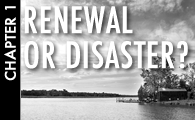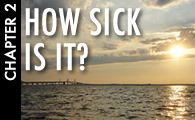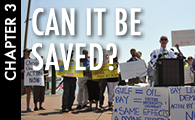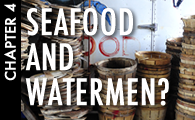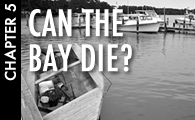
The Nanticoke River on Maryland's Eastern Shore. (Photo by Jason Lenhart - News21)
Chapter 1: On the Brink of Renewal — or Disaster?
Death is largely invisible in the Chesapeake Bay.
It lurks beneath the surface of its shallow, grey-blue waters, where people can’t see the oxygen being sucked out by algae blooms resulting from too many nutrients seeping in from the bay’s rivers.
Decades of agricultural runoff, population growth, development and sediment have overwhelmed the resilient but fragile Chesapeake, creating an underwater “dead zone” of oxygen-free water that scientists say is the nation’s third largest. The result is a contaminated, soupy mess leading to no-swimming days, fish kills, the decimation of the oyster population and a degradation of the natural life of the bay.
Now the battle to pull the Chesapeake back from the brink of ecological disaster is getting help from President Obama, who has ordered federal officials to do more to fight bay pollution and revive a 26-year-old effort by the watershed states to restore the bay’s health. Obama’s efforts have raised hopes that the delicate estuary might be moving to a new brink—of renewal.
“For the last eight years the environmental cop has not been on the beat,” says J. Charles Fox, senior advisor to the Environmental Protection Agency administrator. “And we are trying to change that at EPA now, and we are being much more aggressive in the enforcement action that we are taking.”
In May 2009, Obama issued an executive order telling the Environmental Protection Agency to come up with specific limits on the pollution that states can flush into their rivers and therefore into the estuary. Last month, the EPA gave the states pollution-reduction targets and ordered them to develop plans to meet them by the end of the year.
To bolster the effort, Maryland Democrats Sen. Benjamin L. Cardin and Rep. Elijah Cummings introduced federal legislation giving the EPA more authority and money to enforce the so-called pollution diet. Passage in an election year, however, is far from guaranteed.
Encouraging signs are popping up. Some of the bay’s rivers showed improvements in water quality in the annual study released this year by scientists at the University of Maryland Center for Environmental Science. And two years after Virginia and Maryland imposed major restrictions on catching female crabs, a bay-wide count of the Chesapeake’s iconic blue crabs show their numbers are up sharply—though still down from a decade ago.
But environmentalists have heard political promises before. They fear the same forces that thwarted prior clean-ups—including an inability of state and local agencies to enforce environmental laws, and heavy pressure from the poultry and development industries—remain in place today.
That is one reason environmental advocates who belong to a “riverkeeper” alliance have been filing lawsuits and taking other actions to hold bay-area governments and polluters more accountable to requirements of the federal Clean Water Act.
Giving states the ability to set their own rules and standards “doesn’t work,” says Assateague Coastkeeper Kathy Phillips, one of more than a dozen riverkeepers heading up volunteer organizations throughout the Chesapeake. “It comes down to the governors of the bay states to have the will," she says, "and have legislation that respects federal law and not find ways to compromise it.”
Scientists worry that restoring the bay has grown more difficult with every passing decade. They say the Chesapeake passed a tipping point in the 1980s, hitting a level of impairment so severe that it became progressively harder to clean up because the ecosystem suffers more degradation from even less pollution. So even though the levels of nitrogen, phosphorous, sediment and other pollutants entering the bay appear to have stabilized, the fish-killing “dead zones” continue to grow.
“Once you pass the tipping point, it is hard to go back to the previous state,” says Robert J. Diaz, an expert in marine dead zones who works at the Virginia Institute of Marine Science. He says the bay is still resisting efforts to clean it up “because it takes less to disturb it than before.” (See the full interview.)
Some environmentalists believe the Chesapeake is already a disaster.
“The Bay is an ecological zombie – it is the living dead,” says Howard Ernst, who teaches political science on the shores of the Chesapeake at the U.S. Naval Academy and writes about policies needed to clean up the estuary. “You’d have to work really hard to make it much grosser than it is today.”
Michael Kemp, a professor at the University of Maryland Center for Environmental Science, says the watershed's pollution record for the last decade is mixed. While the upper waters of the Patuxent and Potomac rivers are getting clearer and underwater vegetation is making a comeback, he says the Choptank River, flowing through heavily farmed land on Maryland's Eastern Shore, is worse.
Pinpointing reasons for improvements can be hard. For example, there has been a sharp reduction in nutrient load in the area of the Susquehanna flats, where the river dumps in to the bay, but nobody knows why. "It's hard to say what the cause-effect link is," he says. "It's going to take more scientific exploration to see."
The Chesapeake cleanup is being closely watched around the country—and beyond—because its pollution problems mirror ecological challenges in hundreds of coastal zones worldwide.
Across the United States, farmers and developers are eyeing the struggle nervously, fearful that any costly regulations imposed to revive the Chesapeake could be extended to their troubled watersheds, too.

